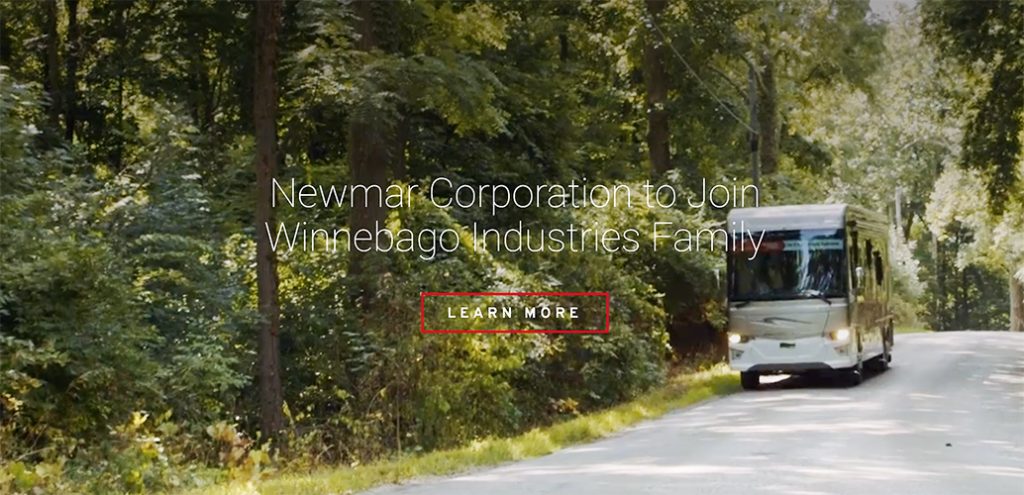By Eric Smith
<span style="color: #999999;">Winnebago Industries Inc.’s $344 million acquisition of luxury recreational vehicle maker Newmar Corp., announced earlier this week, was obviously a market-shifting move for the industry.
The Eden Prairie, MN-based RV manufacturer added both a solid financial performer thanks to Newmar’s annual revenue of $661 million and adjusted EBITDA of $55.2 million, plus a strong complementary asset thanks to Newmar’s reputation for producing premium Class A and Class C motorhomes.
Also, Winnebago had less than a 3 percent share the RV market in late 2015, but when the company closes on this transaction in the middle of December, its market share in the North American RV market will be in the double digits with an opportunity to climb higher if the company can pull the right organic growth levers.
What’s more, Newmar expands Winnebago access to a new market segment just as the acquisition of Grand Design Recreational Vehicles expanded access to premium and standard towables, and the acquisition of Chris-Craft provided access to premium boats—all of which complement Winnebago’s core strength in standard product offerings.
“We have an ambitious goal of transforming Winnebago Industries into a premier outdoor lifestyle company, made up of brands that have common threads around quality, innovation and service,” Winnebago President and CEO Michael Happe told analysts and investors on a Monday morning call. “In our view, that means premium brands, premium products, premium channels, premium talents and hopefully premium profitability over time.”
Click here to read more about the Winnebago-Newmar deal.
What does being an “outdoor lifestyle company” entail? First, some basics of the Newmar acquisition and Winnebago’s standing in the RV market.
Under the terms of the deal, Newmar will operate as a standalone unit within Winnebago Industries, and Newmar’s management team will remain in place and continue to operate out of the company’s Nappanee, IN, headquarters. Newmar CEO Matt Miller will report directly to Happe.
<span style="color: #999999;">As part of Winnebago’s goal to take share in the RV market—both motorhomes and towables—the strategy of filling out its portfolio with brands that appeal to different segments is clearly working, and more could be coming. The Newmar acquisition is Winnebago’s third in recent years, and the acquisition strategy has been balanced among RVs (Newmar), towables (Grand Design) and the adjacent marine category (Chris-Craft).
When asked about the possibility of more M&A in the RV space, Happe said the company is considering it, but he was unsurprisingly evasive, bringing it back to conference call’s focus on Newmar.
“Is there a possibility that we could be further inorganically active in the RV space? Well, sure,” Happe said. “But this is a strong step forward to completing in many ways the business model that we envisioned for North America.”
Adding to its well-rounded collection of assets could help Winnebago deal with RV market slowdowns, much like the one happening now. But a diverse product offering is critical even in upbeat markets, and the RV business is projected to rebound in 2020, according to many analysts.
More importantly, there is a continued blurring of the recreational vehicle and outdoor lifestyle categories, and that trend has Winnebago optimistic for both acquisition and organic growth in each.
That white space—the “outdoor lifestyle” category—is where the company could be playing next, as it did with last year’s Chris-Craft deal. What does that look like exactly? First, a step back to January 2016, when Happe joined Winnebago.
At that time, Winnebago’s board of directors set three simple priorities for the company’s path forward, he noted.
“One, restore our leadership in the motorized RV segment,” Happe said, “Two, establish a compelling towables RV platform, becoming more relevant and competitive. And three, diversify into profitable diversification, potentially the entrance into adjacent outdoor lifestyle segments.”
So far, so good, and it’s clear based on Happe’s later comments Monday morning that buying Newmar indeed propels Winnebago along its journey to becoming a true “outdoor lifestyle” company if only because it gives the company so much scale in the marketplace.
“We remain no less intense on our goal of becoming an outdoor lifestyle company with material presence in different outdoor lifestyle segments,” he said. “M&A is sometimes about timing and what opportunities become available at certain times. We are very active in looking at other outdoor lifestyle segments and adjacencies in terms of what could be a good fit with our competencies, capabilities and a fit with the north star that from a vision standpoint we’ve really put down as a guidepost. So, therefore, it is highly likely that someday in the future that we will expand, continue to expand outside of the RV industry.”
Moving outside the RV industry with the Chris-Craft deal was one way, with Happe stating that, “We are very pleased with Chris-Craft in its first year of results. They have exceeded our financial models that we based our M&A decision on.”
But what else does that look like? At a time when Camping World Holdings Inc. is exiting the outdoor retail world while dealing with a host of other issues, could the possibility of Winnebago entering it be on the table?
There isn’t any clarity around this yet, but look for the company to use tailwinds following the Newmar deal to cross those blurred lines into something more aligned with the core outdoor space.
“We will be poised someday in the future to continue looking at more additions,” Happe said, “particularly and potentially the diversification of the portfolio in the outdoor lifestyle markets.”
Photo courtesy Newmar Corp.
















